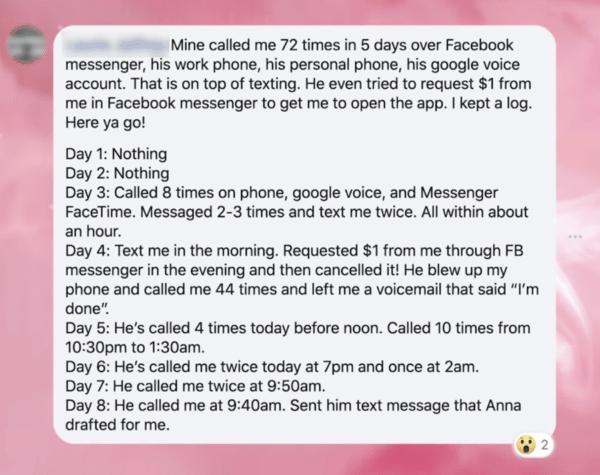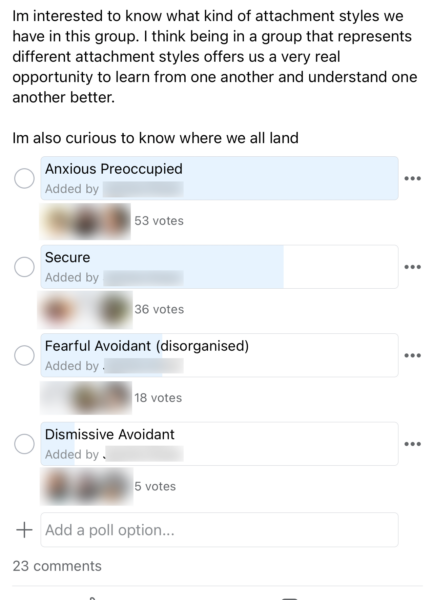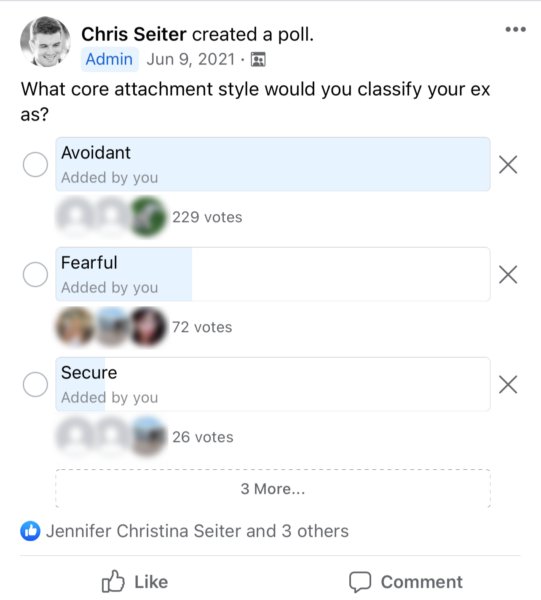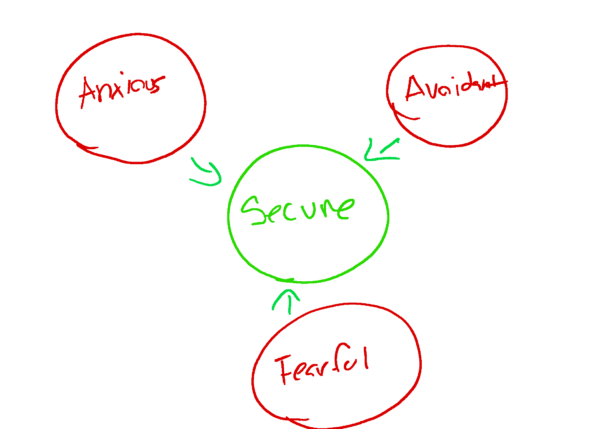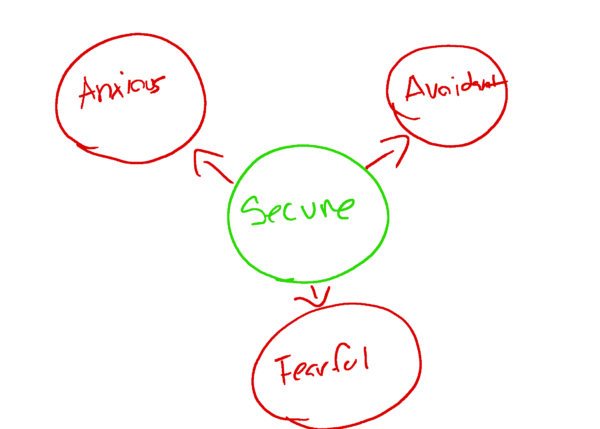Today I’m going to be answering how likely it is for a co-dependent ex to come back after a breakup
To cut right to the chase,
I think that if your ex is a co-dependent they’ll be more likely to come back. However, that doesn’t necessarily mean you should take them back (we’ll explore this later).
There’s a lot to discuss with this one so I want to divide the talk up into four parts.
- First, I want to look at what the most common co-dependents “symptoms” are
- Second, I want to talk about the link between anxious attachments and codependency.
- Third, I’d like to pinpoint which of their symptoms make them more likely to return after a breakup
- Fourth, I’d like to have an honest discussion on if you should be taking this person back
Let’s begin!

What Are Your Chances of Getting Your Ex Boyfriend Back?
Take the quizTaking A Look At The Most Common Co-Dependent Symptoms
There’s a lot of talk out there about what symptoms co-dependents have.
Some researchers suggest 15…
Others 10…
As for me, I personally think there are twelve.
- Low Self-Esteem: Codependent people often struggle with feelings of worthlessness or not being good enough, and they may seek validation primarily or exclusively from others.
- People-Pleasing: Codependents may have a strong need to please others, often at their own expense. They may struggle to say “no” even when it’s in their best interest.
- Caretaking: Codependents often feel compelled to take care of others to the point of self-sacrifice or neglecting their own needs.
- Reactivity: Codependents may have an extreme emotional reaction to other people’s thoughts and feelings, and they often take things personally.
- Poor Boundaries: Codependents often have difficulty recognizing where their own needs, feelings, and identity end and others begin. This often leads to taking on the emotions or problems of others as their own.
- Control: Codependents often feel a need to control others, whether that’s through manipulation, guilt-tripping, or even giving advice without being asked.
- Dependency: Codependents may feel unable to function without the other person and fear abandonment. They may stay in unhealthy situations because they’re afraid of being alone.
- Denial: Codependents often deny or downplay their own feelings and needs, and they may not recognize that their relationship is unhealthy.
- Problems with Intimacy: Codependents often have issues with trust, closeness, and expressing their feelings.
- Poor Communication: Codependents may struggle with expressing their thoughts, feelings, and needs clearly, often for fear of rejection or conflict.
- Obsessive Thinking: Codependents often obsess about other people and their problems. They may spend a lot of time thinking about how to help or change the other person.
- Chronic Stress or Anxiety: Being codependent can be emotionally exhausting and may lead to chronic stress or anxiety.
But in my opinion there are four specific “symptoms” that make a co-dependent more likely to come back.
Taking A Look At The Four Symptoms That Make An Avoidant More Likely To Return
So, let’s cut right to the chase.
what are the four symptoms?
- Poor boundaries
- Chronic anxiety
- Obsessive thinking
- Control
Alright, so let’s discuss the poor boundaries aspect first.
Symptom #1: Poor Boundaries
You know, the thing about people with codependent tendencies is that they’ve grown so used to neglecting themselves that they don’t really think much of themselves.
Often, when they go through a breakup, because they don’t have the boundary allowing you to have space (assuming you broke up with them), they’re not likely to respect the boundary of the breakup.
Case in point:
This was one of our clients experiences with a very anxious ex after a breakup.
What’s interesting about this discussion is that the poor boundary aspect led me to start doing a lot of research on whether codependents are more likely to initiate the breakup or more likely to be on the receiving end of the breakup.
After researching, I couldn’t really find a ton of answers on this.
Most of the research on codependents doesn’t relate to breakups that much.
Yet, if I were to make a hypothesis or an educated guess,
I would say that a codependent is most likely going to be on the receiving end of the breakup as opposed to initiating the breakup.
This is because while a codependent may recognize that they are in the midst of a toxic or unhealthy relationship, they’re not likely to have the boundary to stand up for themselves or end that relationship.

What Are Your Chances of Getting Your Ex Boyfriend Back?
Take the quizOften, the boundary will have to come from the other person.
And those poor boundaries extend, of course, into the post-breakup period.
They will often not be respectful of your need for space.
(Again, see the screenshot I attached above for proof of that.)
They will often be the ones to reach out constantly seeking or needing reassurance.
(Again, screenshot 😉 .)
Sometimes they’ll flat out beg for you back.
Sometimes they’ll leave notes at your door.
It can feel a little alarming, but this is all because they don’t really have a sense of boundaries due to their self-neglect.
Symptom #2: Chronic Anxiety
The second symptom that, in my opinion, makes them more likely to return is chronic anxiety.
Chronic anxiety is a fact of life for many people with codependence.
As I stated above, being codependent can be an emotionally exhausting experience that actually predisposes them to a life of chronic stress or anxiety.
What’s always interesting about this discussion to me is how it boils down to the common belief about the five most stressful life experiences:
- The death of a loved one
- Moving
- Major illness or injury
- Job loss
- Divorce.
The divorce aspect comes into play here because, while we’re not dealing specifically with divorce for the purposes of this discussion, we are dealing with breakups.
Breakups are very similar to divorces, especially for someone who’s a codependent ex.
Typically, when we go through incredibly stressful experiences, it can lead to an exacerbation of our anxiety.
When you’re dealing with a person who is already anxious or stressed, such an experience simply turns the anxiety knob up to 10 or 12.
Which ultimately can lead them to….
Symptom #3: Obsessive Thinking
So, codependents will obsess constantly about the breakup.
They can’t get you out of their mind.
What’s always interesting to me about this is the idea of implementing a ‘no contact’ rule on someone with an anxious attachment style or someone who is very codependent.
A lot of times, what we’ve noticed in our coaching practice is that most of our clients have an anxious attachment style.

What Are Your Chances of Getting Your Ex Boyfriend Back?
Take the quizTheir exes are almost polar opposites.
The most common pairing we see from an attachment style perspective is an anxious client and an avoidant ex. So, most of our advice is geared from that perspective.
In that case, you want to give the avoidant partner a lot of space.
The ‘no contact’ rule almost seems like a perfect fit if you’re looking at this like a puzzle. But the ‘no contact’ rule has a really interesting effect on someone with an anxious attachment style or someone with codependent tendencies.
As someone who’s codependent is obsessively thinking about you and experiencing chronic anxiety, the silence can actually further aggravate them.
It’s interesting to consider the time dilation aspect that goes along with the ‘no contact’ rule.
One of the things we’ve noticed is that individuals in our coaching practice who have an anxious attachment style may feel that the ‘no contact’ period, let’s say of 30 days, feels like double the time.
Whereas if you have an avoidant attachment style, that ‘no contact’ rule can feel like half the time, like only 15 days instead of 30.
A lot of this is because an avoidant isn’t going to engage in obsessive thinking. All of these symptoms are interconnected.
Obviously, poor boundaries can be a result of chronic anxiety, and obsessive thinking can also stem from chronic anxiety.
These symptoms create a challenging situation that can lead the codependent to seek control, which is our fourth and final symptom!
Symptom #4: Control
This symptom, in my opinion, is the one that makes them more likely to return.
So, so far, we have a person with:
- Poor boundaries
- A person who has chronic anxiety, and, because of that chronic anxiety…
- They’re obsessively thinking about you.
The breakup itself has only exacerbated the problem.
So, what does the codependent often try to do?
Well, they try to control.
They obsess about the breakup so much that they decide the only way to fix things is to claw their way back into the relationship to prevent the feelings they’re currently experiencing from happening again.
This is really, really common.
Codependents not only enable but they also try to control every aspect of the relationship because they’re so terrified of being abandoned.
This leads them to adopt the problem-solving mindset that I often associate with anxious attachment styles and talked about exclusively in this interview:
Their primary goal becomes: ‘I need to fix this relationship so this can’t ever happen to me again.
Looking At The Link Between Anxious Attachment Style And Codependency
Generally speaking, someone displaying symptoms of codependency will most likely also exhibit symptoms of an anxious preoccupied attachment style.

What Are Your Chances of Getting Your Ex Boyfriend Back?
Take the quizI mean, if you simply look above at all of the codependent symptoms a lot of them have direct links to the symptoms of an anxious attachment style.
In fact, there’s research to support this.
There’s a fantastic article by a professional therapist in Portland, Jeff Guenther, who specializes in treating relationships marked by codependency and anxious attachment styles.
He found that there indeed is a link.
An anxious attachment style is one that is commonly coined as codependent. People who have an anxious attachment style may feel as though they’d really love to get close to someone, but they worry that that person may not want to get close to them. (Jeff Guenther,LPC)
This connection forms the crux of my argument for why I believe codependent exes are more likely to return.
But should you take them back?
Should You Take A Co-Dependent Ex Back?
All right, let’s lay the groundwork here.
A codependent relationship, meaning one person in the relationship is entirely dependent on the other person, regardless of whether that person is secure or not, has all the ingredients for a potentially toxic experience for both parties.
Yet, when I tried to find accredited studies or peer-reviewed research papers, I couldn’t find any official statistics suggesting that codependent relationships fail spectacularly.
In fact, I found the opposite.
I found numerous statistics indicating that in most relationships, at least one individual adopts a codependent approach.
So, there’s plenty of suggestion out there that codependent relationships are bad and will fail, but I haven’t found anything definitive yet saying they actually will.
So, should you take them back?
Honestly, that’s a decision that I can’t make for you.
What I can do is show you what our personal statistics say about how often getting back together with an ex actually works out.
Here’s What Our Statistics Say About How Often Breakups Stay Together (After Getting Back)
Last week, I wrote a rather insightful article on, ‘Is it bad to get back with an ex?‘
Essentially, I was trying to answer the simple question of whether it’s worth getting back with an ex when there’s a lot of shame and guilt associated with trying.
One of the things that I examined is how often couples who broke up ended up getting back together.
What we found from our own success stories was that there was only a 40% long-term sustainability rate.
This implies there’s a 60% chance that if you reunite with your ex, you’re likely to break up again.
Now, there are measures you can take to prevent that, obviously, but on the whole, the odds are not in your favor. That’s what the statistics suggest, but when I share this with people, it doesn’t usually change their mind.
So, if you do want your ex back, my suggestion would be to adopt a secure attachment gravity mindset.
My Argument For The Secure Attachment Gravity Mindset
I’m very interested in attachment styles and their impact on individuals and relationships.
In my opinion, the goal of understanding attachment theory should always be to achieve a secure attachment style.
I recently came across this really great article discussing attachment style pairings. Specifically, I want to discuss a few of these pairings (and then relate them to secure attachment gravity.)
The Secure and Anxious Pairing
The first one considers how a secure individual might fare if they reconcile with an anxious individual.
I focus on anxious individuals because we know that codependent people often exhibit an anxious attachment style. So, how would a secure individual fare in a relationship with a codependent person?
The anxious person will test the patience of the secure one, requiring more reassurances and leaning towards anxiety when the secure partner can’t respond quickly or reassuringly enough. This pressure may drive the secure partner towards a more dismissive attachment style in interactions, despite their internal security. The excessive demands of the anxious individual would test anyone’s patience. If this issue isn’t too severe, the secure partner can guide the anxious partner back towards security through constant, patient reassurances, even when the anxious partner is being unreasonable.
Essentially, this suggests there will be an internal struggle between a secure person and a codependent person. T
his struggle won’t often be explicitly addressed between the couple in terms of attachment styles, but more along the lines of the symptoms associated with these attachment styles.
The secure person is known for setting boundaries, being patient, and knowing when to offer reassurances and when to allow space. However, the anxious person is often plagued by anxiety and a constant need for reassurances.
The implication is that one party will prevail in this struggle.
Either the codependent person will learn to become less codependent and more secure,
Or the secure person will relinquish their secure attachment and become more avoidant.
So, if you’re not prepared to potentially experience this, assuming you have a secure attachment style, then you might be in for a rude awakening
The Anxious and Avoidant Pairing
And then, of course, we have the most common pairing: dismissive-avoidant with anxious-preoccupied.
This is a classic long-lasting but often dysfunctional coupling. The two types—one undervaluing attachment and the other overvaluing it—create an interlocking dependency filled with stress and anxiety for both. The dismissive partner may prefer having his or her view of others as needy and clingy confirmed and may enjoy the sense of controlling the relationship by doling out just enough responsiveness to keep the anxious partner off balance but on the hook. The dismissive partner may settle in for the long haul, while the preoccupied partner, unsatisfied with the emotional crumbs, sticks around out of fear of being alone and never finding another relationship.
This is one of the most common relationship dynamics.
What this should teach you is that when dealing with someone who has a codependent tendency, the primary goal is for at least one partner to become more secure in the relationship.
If that doesn’t occur, you’re likely in for a very toxic experience.
So, if you’re not prepared to cultivate that mindset or do the necessary work, you likely shouldn’t reconcile with a codependent ex.
